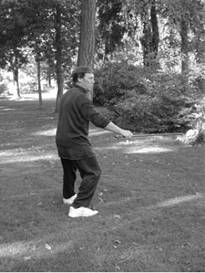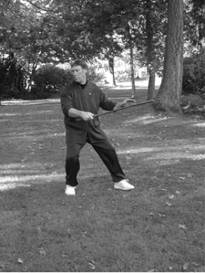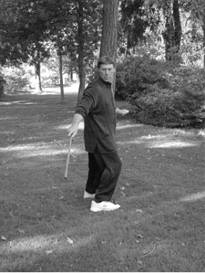 Gilman Studio On-Line Lessons
Gilman Studio On-Line Lessons
Tai Chi Partner Cane Form
This Lesson Contains:
Movement #10 – Break Branch and Raise Dust
This is the most complicated and fun move for A side. It contains two parts – a block, then an attack. As B attacks the temple, A steps back and either stops or breaks B’s cane. He then follows with the second part of the move where he knocks B’s cane off to his right, circles around and in to the left, and attacks the back of B’s knee. There is one other possibility. A can just drop his cane a bit as B’s cane moves by, and help it along by knocking it rather hard. He then circles in for the attack. It is important to realize when studying these pictures that even though some of the postures might seem rather awkward, they flow well when spinning around. It is hard to take pictures of spinning movements. I advise you to print this lesson out so you can easily follow the progression of each view as the spin happens. It is a bit confusing as the two views are not clearly different at this time. When you purchase the video, you will see this movement much more clearly.
Note: This is a long lesson, six pages, so be patient as it downloads.

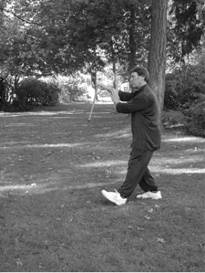 A starts to step back by sinking into the right Kua and rolling up onto the left heel.
A starts to step back by sinking into the right Kua and rolling up onto the left heel.
The cane is going to make a small clockwise circle around the front of the body to gain energy to stop or break B’s attack. Here the tip is dropping. This energy comes mostly from the wrist.
Focus on relaxing into the center.

 Step back with the left foot. The toe points halfway between the facing direction (south) and east. Don’t shift yet. Keep the energy in the right Kua.
Step back with the left foot. The toe points halfway between the facing direction (south) and east. Don’t shift yet. Keep the energy in the right Kua.
The cane continues to circle overhead.
Focus on the target (the opponent’s cane).

 Shift the weight onto the left foot and pivot in the right toe to face south. The torso turns a bit more to the left with the cane slightly to the left of the body to block the opponent’s strike. The left hand touches the right forearm. Keep the elbows and shoulders relaxed.
Shift the weight onto the left foot and pivot in the right toe to face south. The torso turns a bit more to the left with the cane slightly to the left of the body to block the opponent’s strike. The left hand touches the right forearm. Keep the elbows and shoulders relaxed.
Focus on the cane about a third of the way down from the tip.
Note: The power for this movement comes from the legs, transmitted to the hips and waist, and finally to the arms and cane. It is very important to keep the chi in the right Kua until you are ready to snap it out into the cane.
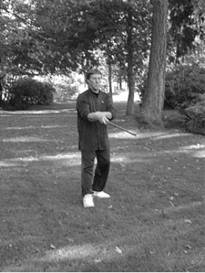
 At this point, the two canes will be in contact, with B’s on the inside of A’s. Awants to knock B’s cane to his right, spin in and around to the left and attack the back of B’s leg. First he must drop the cane tip so it can move to the inside and knock B’s cane to the right.
At this point, the two canes will be in contact, with B’s on the inside of A’s. Awants to knock B’s cane to his right, spin in and around to the left and attack the back of B’s leg. First he must drop the cane tip so it can move to the inside and knock B’s cane to the right.
There are no foot or torso movements at this time.
Drop the cane tip. This is done with the wrist. Don’t drop too far, only enough to clear partner’s cane.
Focus on dropping the tip.
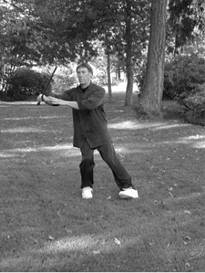
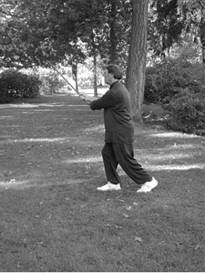 Knocking the cane out of the way and starting to step in.
Knocking the cane out of the way and starting to step in.
1) Shift the weight onto the right foot and replace the left foot in front of and slightly to the left of the right foot. The toe heads halfway between south and west.
The right elbow and wrist flick the cane to the right, as if knocking partner’s cane to the right. It is a solid, quick movement.
2) This picture is actually the first part of the flick and step. Here A is shifting the weight onto the right foot to free up the left foot for stepping.
Focus on the cane tip for knocking the opponent’s cane.

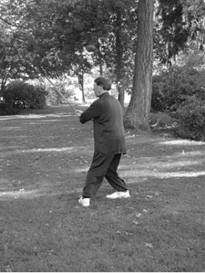 Continuing to step in and around.
Continuing to step in and around.
The body is turning to the right. The weight is shifted onto the left foot. The cane is relaxing and coming down to waist level. The eyes lead this movement.
Once again, picture #2 is slightly behind #1. Here the left foot has just stepped, but the weight isn’t yet shifted.
Focus on turning to the right.
Note: Notice from picture #2 to picture #1 how the cane starts to lower as the turn progresses.
 The turn continues.
The turn continues.
The torso continues to turn right, lead by the eyes. I am looking toward my intended target which is now behind me.
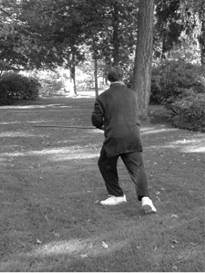
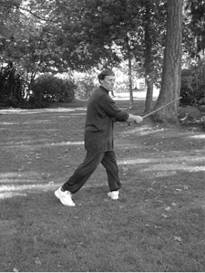 This is the most awkward part of this movement when done slowly.
This is the most awkward part of this movement when done slowly.
Step behind yourself with the right foot and touch down the toe to face east. The torso continues to turn right. The cane is about waist level. Continue to gaze right.
Shift the weight onto the right foot. The left foot has a bit of root in its heel. The torso continues to turn right. It now faces about east.
The right arm now starts to attack down and to the right. It is aiming at the opponent’s knee. The opponent is now behind me.
Focus on the target.
Note: You will find it necessary to refer back to the application pictures to get an idea of directions.
The weight is fully on the right foot. The left foot remains on the ground. The torso has turned a bit further to the right and faces east or a bit more to the right.
The right arm is extended to the right side with the focus behind the body. Notice the angle of the cane and arm. The left arm has moved left to balance the sharp swing down with the cane to the right.
Focus on the tip.

